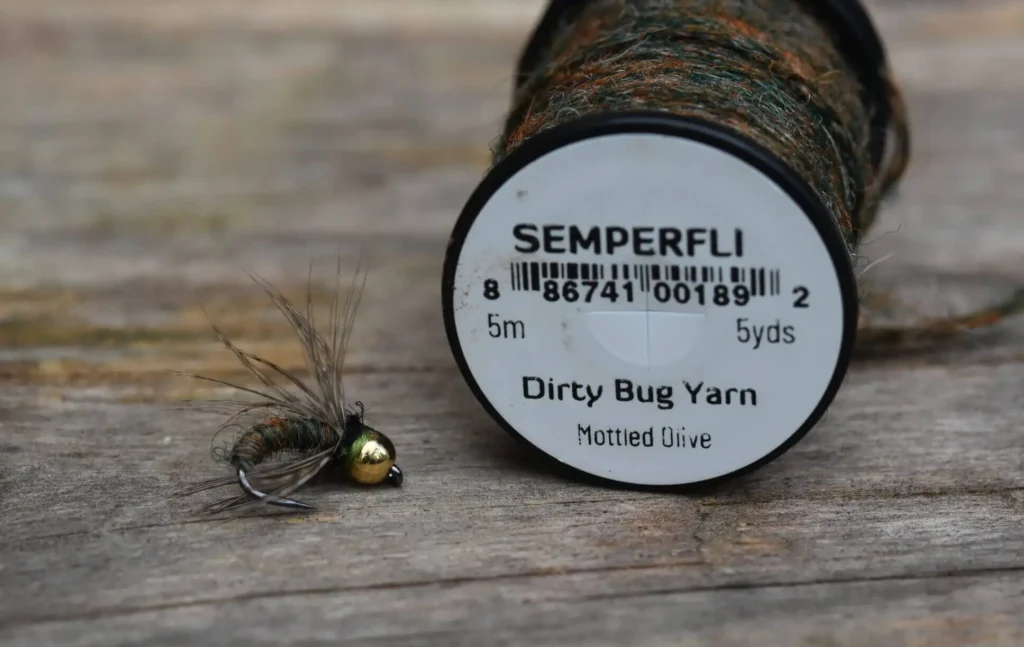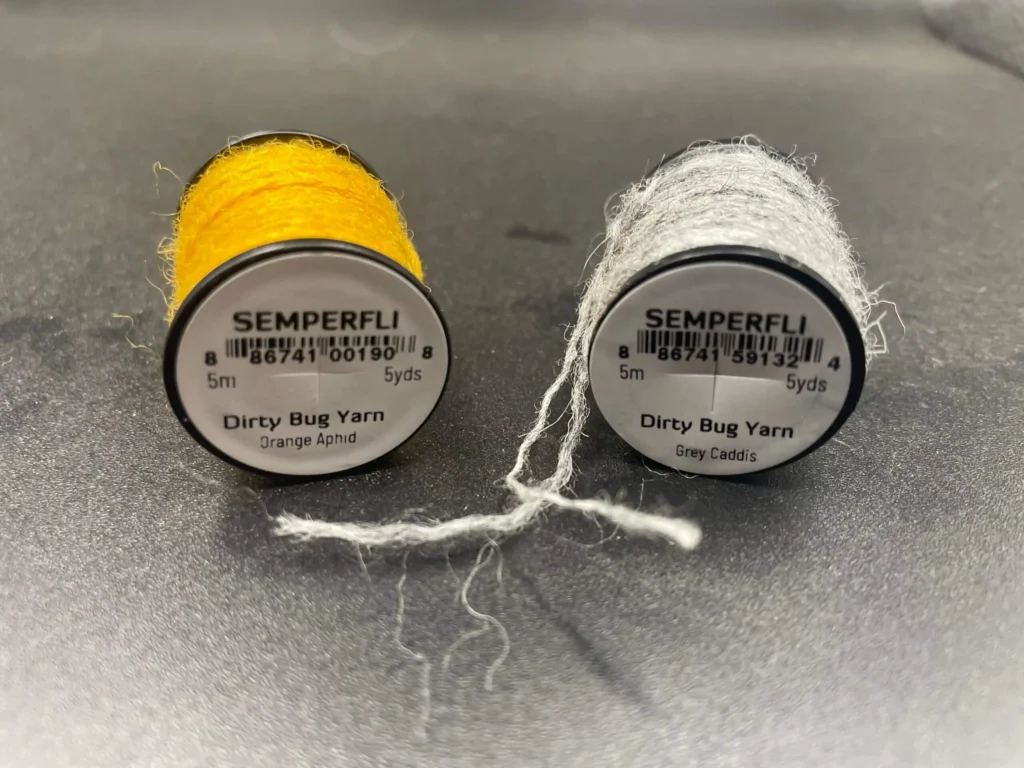Tying with Semperfli Dirty Bug Yarn

Semperfli’s Dirty Bug Yarn is a specially designed mix of natural and synthetic materials, and in many ways reminds me of a modern version of Chadwick 477, the original material used to tie patterns such as the Utah Killer Bug. In fact, Semperfli also now offers a material called Chadwick 477 Substitute for tying this pattern. Dirty Bug Yarn differs in texture and properties, though, and in some ways is a more versatile option.
Recently, I bought eight different colors of Dirty Bug Yarn, typical of my “in for a penny, in for a pound” mentality. I was a little surprised by the yarn’s coarse texture – at least compared to yarns such as Jamieson’s Shetland Spindthrift, the long-time replacement for Chadwick 477 prior to Semperfli’s new substitute mentioned above. However, there’s no doubt this is a very versatile yarn with a number of applications at the fly tying vise and on the water.
Properties of Dirty Bug Yarn
Dirty Bug Yarn is a woven mix of natural and synthetic materials. Unlike many other yarns and wools, Dirty Bug Yarn has a great mottled mix of colors that combine to produce each product.
Examine any natural nymphs closely and you’ll likely see that very few insects – and very few things in nature – actually consist of a single color. They are often made up of multiple colors, tones, and intricacies that make each of them unique. A Blue Wing Olive nymph, for instance, often has hues of brown, black, and olive that combine to produce the overall olive appearance. That’s where Dirty Bug Yarn comes in.
To achieve the mottled naturalism of many nymphs, fly tyers have often had to blend various dubbings. This takes time, and unless you use something like a coffee bean grinder to blend them, the results can vary, mainly due to human error. It’s hard to mix the exact quantities of colors in the exact way every single time. From personal experience, some of my nymphs turned out darker, and some lighter, depending on quantities of each color used and how they were mixed. How much these slight discrepancies actually impact the effectiveness of a pattern could be argued, but one of the goals of serious fly tyers should first and foremost be consistency. Dirty Bug Yarn certainly helps us achieve consistency.
Tying with Semperfli’s Dirty Bug Yarn
Dirty Bug Yarn is a rope-like, two-strand product. I’ve heard Dirty Bug Yarn described as “dubbing on a rope” and that’s fairly accurate. It can certainly help you produce tighter, more consistent bodies on your nymphs, wet flies, and even emergers. There are enough pockets within the material to trap air, which gives the material neutral buoyancy, and it accepts dry fly floatant fairly well, if patterns need to be fished on top or in the film. If you want to tie dry flies with this style of material, though, you may want to check out Semperfli’s Dry Fly Polyyarn. With Dry Fly Polyyarn you get the benefit of the Dirty Bug Yarn concept of mottled colors but with increased floatation properties.
For larger nymphs, size 8-14, Dirty Bug Yarn can be used “as is” right off the spool. For smaller flies, separate the strands and use only one to wrap the body. This works well for me even on flies as small as size 20-22 without creating too much bulk.
One of the strengths of Dirty Bug Yarn, I believe, is the ability to create segmented bodies, if you so choose. After tying in a strand of yarn, tie in a piece of wire or mono rib. Twist the yarn to create a tighter chord and then wrap the body. Over top of the body, wrap the ribbing of choice so that it falls into the junction of each wrap. This will accent each wrap and create more defined segmentation.
The most common patterns I tie with Dirty Bug Yarn are caddis imitations. My favorite is what I’ve dubbed “The Dirty Bug Caddis,” which is a soft-hackle-style fly that has produced a ton of trout for me the past year. My favorite colors are Mottled Olive, Caddis Pupa, and Caddis Brown, but this same pattern could be tied using every color of Dirty Bug Yarn offered by Semperfli and still produce fish.
From what I can tell, Dirty Bug Yarn is offered in roughly 27 colors. Some of these have only minor differences, but there are enough options here to match specific insects found in the waterways you fish. To create even more options and potential contrast in your patterns, try using a strand from two different colors and wrapping them together.
Although Semperfli offers a Chadwick 477 Substitute specifically for tying Utah Killer Bugs, the Caddis Pupa colored Dirty Bug Yarn is also a good alternative for this pattern. I use other colors of Dirty Bug Yarn to tie other variations of the Utah Killer Bug, too. For instance, another simple caddis pattern is to wrap a body using Dirty Bug Yarn and then add a collar of peacock or dubbing of choice.
Another way to use Dirty Bug Yarn is to “rough it up” to loosen up the various little fibers. You can do this once it is on the hook shank with a wire brush to create an attractive furry body, or do this ahead of time until you have enough loose fibers that can then be twisted into a dubbing noodle for the body or collar of any fly.
The uses for Semperfli’s Dirty Bug Yarn are practically limitless. Nymphs, wet flies, emergergers, and even dry flies can be tied with this product. Pick up a few colors to experiment with and get creative.

Tying the Dirty Bug Caddis
Materials used to tie the Dirty Bug Caddis
- Heavy curved, short shank nymph hook in #12-18. The Model 10 from Wholesale Fly Company is a great option for this pattern. For a barbless, Euro nymph option, check out the Model 11, also by Wholesale Fly Company.
- Round tungsten bead in copper, silver, gold or black.
- 8/0 Classic Waxed Semperfli Thread in color of choice.
- Body: Dirty Bug Yarn in color of choice.
- Ribbing (Optional): XS wire in color to match the bead or mono rib.
- ThoraxCollar: UV dubbing, Ice Dub, Senyo’s or Arizona Synthetic in a color that contrasts with the the Dirty Bug Yarn body.
Did You Find This Fly Tying Guide Helpful?
Stay up to date with the Dark Skies Fly Fishing monthly newsletter for free and receive the latest posts in fly fishing news, tricks, tips, and techniques, stream reports, as well as updates on new flies added to the Online Store and exclusive discounts!
Sign Up NowHave a fly fishing question you’d like answered? Drop us a line at info@darkskskiesflyfishing.com! If we use your question in a blog post or in the newsletter, we’ll send you a FREE fly box with a dozen of our favorite nymphs and dry flies!



Shetland Spindrift yarn is a 2 ply variegated wool yarn. Will make the same type patterns without synthetics.
You can split the plies to mix and match colors too. Wool tends to be darker when wet.
115 yards for around $10
I have used Shetland Spindthrift extensively and agree with you. The Semperfli Dirty Bug Yarn is a decent replacement, though, and available in more “buggy” colors. I also like that it’s readily available through most places where I buy other tying materials, so I don’t have to place an extra order and pay extra shipping.
Thank you for reading and for your comment!
I also exclusively love Shetland Spindrift yarn, especially the oyster pink color, for tying fleshy bodies on wormy larvae patterns. That stuff flat out catches fish!
Nonetheless, I am intrigued by the appearance coupled with the convenience of this “Dirty Bug Yarn” by Semperfli, too. I am going to order a few spools from Precision Fly and Tackle soon.
Ralph, what colors are your favorite that you suggest that I purchase first?
Justin
Hey Justin,
Thank you for your comment. I’ve definitely become a fan of Dirty Bug Yarn the more I’ve used it. I also like that it’s available in more varieties than the Shetland Spindthrift. My favorite colors are Mottled Olive, Caddis Pupa, Mottled Caddis Green, and Shrimp. I think you’ll find the Caddis Pupa to be very similar in color to the Shetland Spindthrift that you use to tie Killer Bugs.
Here’s a link to Dirty Bug Yarn on the Precision website: https://precisionflyandtackle.com/products/semperfli-dirty-bug-yarn?_pos=2&_psq=dirty&_ss=e&_v=1.0&ref=fpNnc7VK5A5FNO&variant=45523313459517
Thanks for your input and best of luck!
Ralph